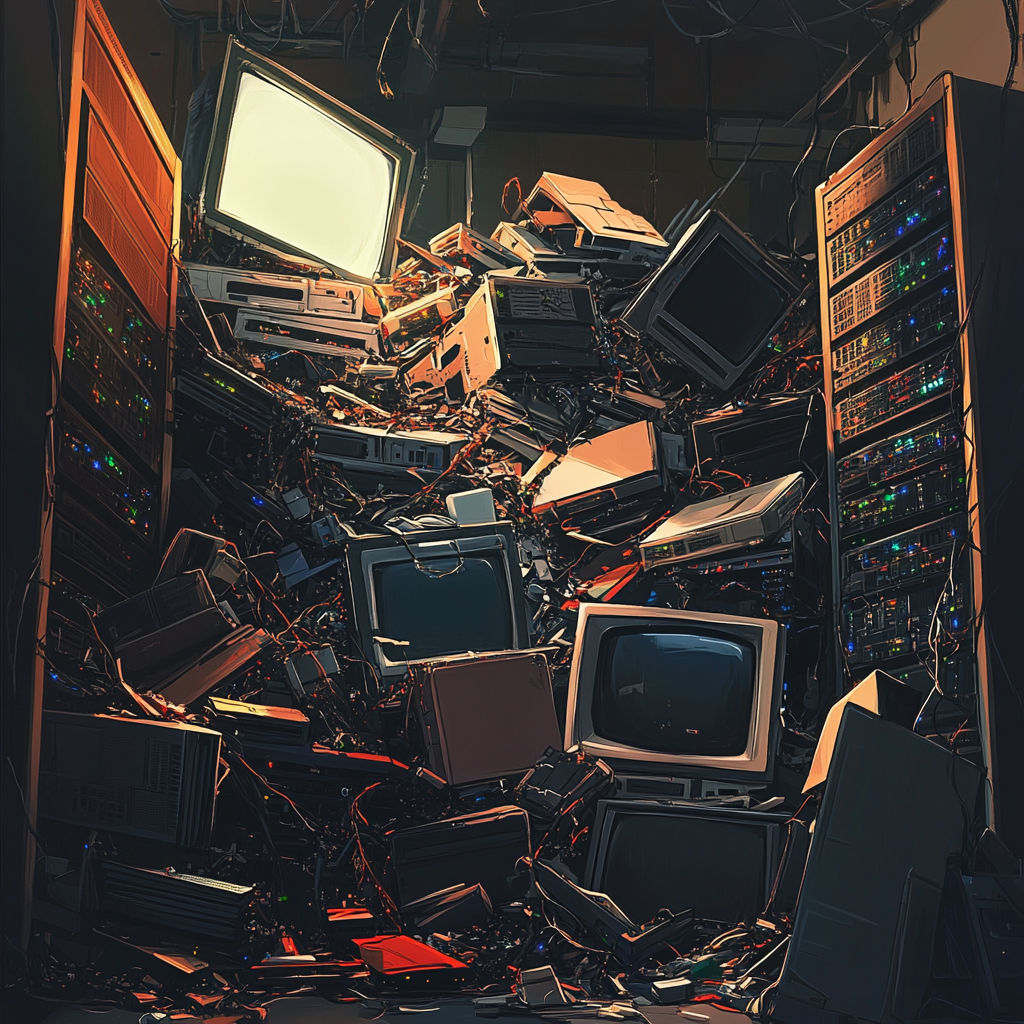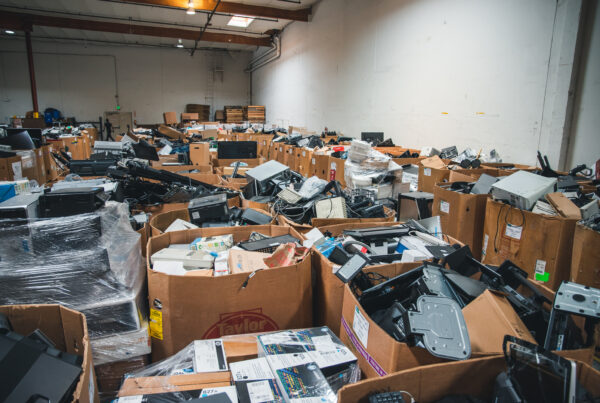Data center recycling may not seem like the most sexy topic. But data center operators and managers know the stakes are high. E-waste generated by data centers has reached crisis levels. It is proving an unprecedented threat to the technology sector, the data center industry, businesses dependent on them, and the future ecological well-being of the planet.
Data centers create e-waste when they dispose of their worn out or outdated server, storage, and networking equipment. It is also generated as part of their formation and running processes.
Traditional recycling attempts to help solve the problem of data center e-waste by reinserting used materials of value back into the system. This aims to simultaneously ease the problems of a shortage of those materials and the finances required to acquire them.
But is this the best or only option?
Table of Contents
- How Serious is the E-Waste Problem in Data Centers?
- The Limits of Data Center Recycling as a Solution to E-Waste
- What Can Data Center Operators Do Right Now to Elevate Their E-Waste Disposal Beyond Traditional Recycling?
- Contact us today to learn how our secure ITAD services can help you implement a successful e-waste management program for your data center.
How Serious is the E-Waste Problem in Data Centers?
To appreciate the seriousness of the problem of data center e-waste, and the surprising part played by traditional recycling, we need some facts and figures.
Statistics on E-waste and ITAD Recycling
The latest, large-scale research conducted by the UN and reported in the Global E-Waste Monitor has found that:
- 61.9 million metric tonnes of e-waste was generated in 2022 and it is rising by 2.6 million tonnes annually
- Only a paltry 22.3% of the actual e-waste mass was documented as properly collected and recycled
As we will see, data center recycling methods can sometimes contribute to these figures.
Statistics on E-waste and Data Centers
The e-waste produced by data centers is a major issue for US businesses in terms of environmental impact and additional costs.
As of March 2024, Statista published that there were:
- 5381 data centers in the US alone
- Over 500 in Germany (the next largest) and the UK
Research on data centers and the environment conducted by Supermicro revealed that:
- 12% of data centers do not engage in any type of e-waste recycling
- 43% of data centers do not have an environmental policy for dealing with their e-waste
Are Data Centers Bad for the Environment?
Data centers produce all kinds of e-waste. Whatever the type, it impacts the environment negatively in at least two ways: equipment disposal, and data center energy consumption. And the equipment disposed of often isn’t according to best practice.
What Types of Equipment Do Data Centers Dispose of?
What kinds of e-waste components that need recycling are used in Data Centers?
Data center networking equipment
These devices facilitate communication and data transfer within networks. Their primary function is to manage and direct data traffic between different devices and systems. Examples include routers, switches, firewalls, load balancers, and network cables.
Server equipment
These are powerful computers designed to process endless requests, store data, and run applications 24/7. They are the workhorses of a data center, handling computational tasks, as well as storing and handling large amounts of data. Examples include web servers, database servers, application servers, and file servers.
Other data center equipment
This includes everything else that is contained in data center architecture. There are monitors, computing equipment, circuits, and any other electrical components within the infrastructure. Examples include storage systems (like SANs and NAS), power distribution units (PDUs), uninterruptible power supplies (UPS), cooling systems, and racks to house all of the equipment.
What is the Environmental Impact of Data Centers?
Data centers are remarkably energy intensive during operation. Data center power demand accounts for 2% of the total greenhouse emission globally. Data center site managers exacerbate their emissions by not practicing good e-waste management. Improper data center e-waste and networking equipment disposal causes terrible damage to the environment. This could include soil contamination, air pollution, and water pollution.
Data center equipment is often not designed with data center recycling as a concern. Planned obsolescence and short life cycles ramp up the environmental impact of disposal. This is why approximately 0.5% of total US greenhouse gas emissions are attributed to data centers.
We need to tackle the ecological impact of data centers in the widest terms. This includes:
- The material waste they create
- The manufacture of the equipment
- Data center architecture and cooling methods
- The lifecycle of data center equipment
Issues Hindering Data Center Sustainability
There is certainly a need for sustainable solutions for data centers as they dispose of all of their outdated equipment. Two issues hinder this:
- Data centers often dispose of equipment that is out of date rather than out of action. Equipment may be deemed obsolete even though it is still functional. This is a problem with how we define e-waste in the first place.
- There is a history of rapid innovation in many of the varying types of data center technology. Data centers tend to run through their equipment faster because of this. Equipment is not used until it is broken; running equipment is disregarded long before this.
The Limits of Data Center Recycling as a Solution to E-Waste
Before discussing the limits of data center recycling as a method for handling data center e-waste, we need to make it clear that we are not chastising those who recycle their data center equipment. But, we want you to consider solutions such as refurbishment that move us closer to the principles of a circular economy.
The Limitations of E-Waste Recycling
Let’s examine the method of recycling carefully and critically because it is the most commonly cited solution to data center e-waste.
How Does E-Waste Recycling for Data Centers Work?
Before evaluating the limits of recycling as a solution to data center e-waste, we should first understand what it means. E-waste recycling involves the breaking down of electronic devices and equipment into raw materials, which are then used to manufacture new products. Electronics recycling reduces the overall environmental footprint by conserving valuable components and materials for the creation of new products.
The method of e-waste recycling generally includes four stages:
- Collection – E-waste is dropped-off at specified centers for recycling programs to begin
- Sorting – E-waste is classified and separated based on the material’s type and condition
- Processing – The recycling program uses different techniques to extract raw materials that are useful or valuable
- Manufacturing – Recovered materials are used to make new products
This seems like a clear, clean solution to the e-waste problem. So, what are the weaknesses with recycling?
Problems with Recycling as a Solution to E-Waste
There are different types of weakness with the recycling solution.
Volume
The recycling infrastructure is insufficient to tackle our current volume of e-waste. The steep increase in technology production and data center construction unfortunately outweighs the good done by recycling.
Materials
Electronic devices and data center equipment are of a complex composition. Some are unsuitable for electronics recycling due to their outdated or damaged state. Others contain materials that are harmful and toxic, and difficult to separate. Examples include heavy metals (cadmium, lead, and mercury), and brominated flame retardants. This makes environmental contamination hard to prevent.
Process
Recycling is a resource heavy process in terms of cost, skills, and time. The specialist knowledge and tools it takes to separate materials and disassemble intricate devices is significant, as is the energy expended in recycling processes such smelting, refining, and shredding.
Policies
There is a lack of standard recycling policies for e-waste that have universal acceptance. The result is that there is no agreement across counties and industries on the best methods for recycling different e-waste types.
Ethics
Unfortunately, investigations have uncovered unethical practices among some recycling companies (see the Basel Action Network investigation in 2016). Reports include the export of e-waste to landfills in developing countries, or illegal e-waste operations like burning unused materials as scrap. This releases harmful chemicals into the atmosphere with negative health implications, such as lead poisoning, or lung and respiratory diseases. This is why employing certified IT Asset Disposition (ITAD) providers is so important.
Perhaps the greatest problem with recycling as a single solution to e-waste is that it ends with the creation of new products. This contributes further to the e-waste cycle, since it produces even more products for processing or disposal. We need another approach.
Fresh Approaches to the Challenges of Data Center Recycling
Reducing the strain of short equipment lifecycles and data center energy consumption makes business sense for data center operators. Given the limits of e-waste recycling solutions, how can they achieve this?
One way is by resigning data center products and processes to be less consumptive. While vital, this is beyond the daily scope of a data center manager’s tasks. Another is by reducing the amount of new equipment purchased by employing maintenance and care measures that extend their lifespan. But what happens when the equipment’s lifespan ends?
Refurbishing and reusing equipment where possible is a better way to protect the environment, increase sustainability, and reduce business expenses than recycling. Rather than salvaging materials of high value for the product of new products, refurbishment provides a way for the equipment as a whole to be relooped back into the life-cycle – a better example of the circular economy at work.
What Can Data Center Operators Do Right Now to Elevate Their E-Waste Disposal Beyond Traditional Recycling?
Data centers can lessen and even recoup their equipment costs by repairing instead of replacing. And, if it’s an item that’s no longer of any use in the data center itself, secondhand data center equipment can be refurbished and even resold.
There are several ways you can improve on your current e-waste recycling solutions:
- Prioritize having your current data center equipment collected and, when appropriate, refurbished so it can be reused rather than just sent out for ITAD recycling
- Consider whether planned new purchases could be reduced in favor of maintaining older equipment
- Start investigating which ITAD providers are known for manufacturing products that contain casings, components, and materials that are more sustainable
Human-I-T helps minimize data center emissions through secure data center equipment disposal. To ensure maximum data security, we provide a comprehensive data destruction process to ensure all security measures are met to the highest standards including NAID AAA and ISO 9001, 14001, and 45001.






